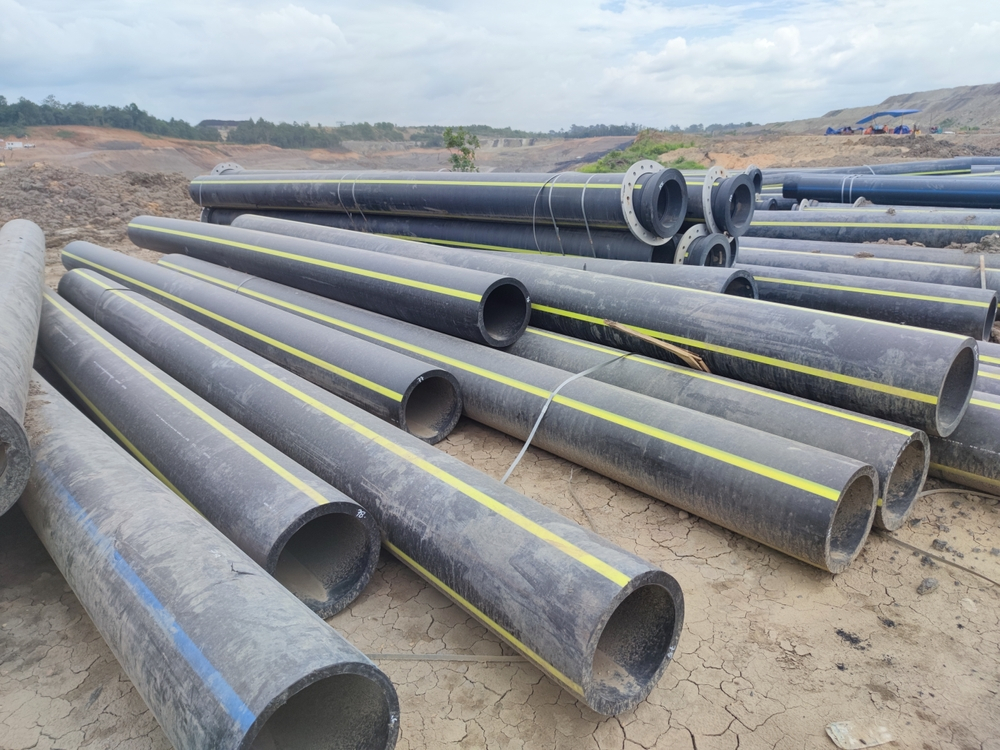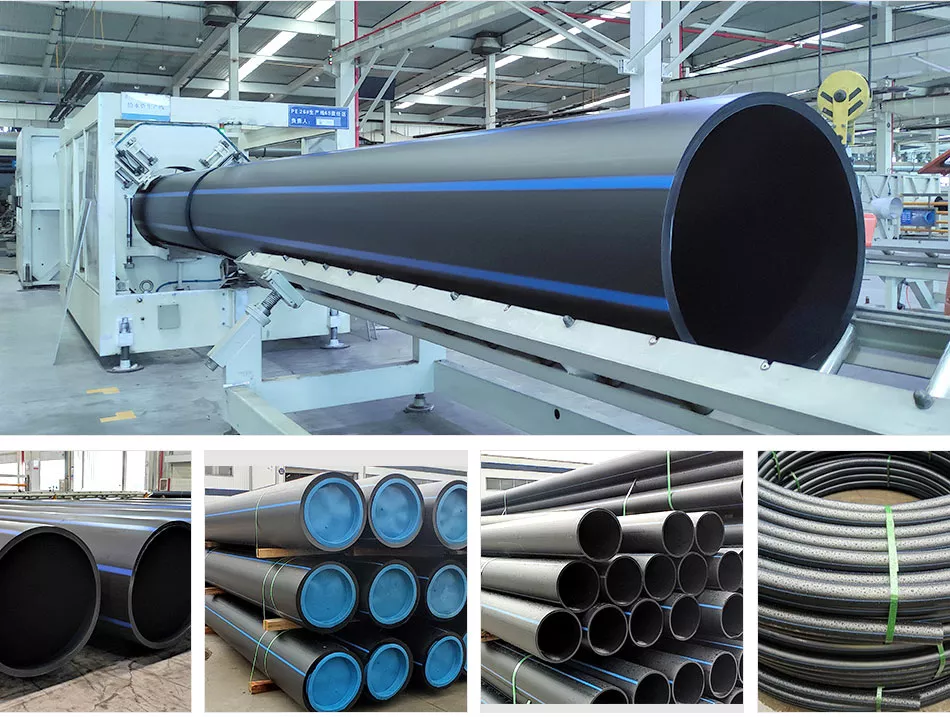Why Partnering with Pipe Supplier American Plastics Midland Ensures Timely Supply
Wiki Article
Explore the Production Process Behind High-Quality HDPE Pipe and Its Applications
The manufacturing process of premium HDPE pipelines is elaborate and methodical. It begins with the choice of basic materials that boost performance. Following this, ethylene undertakes polymerization to develop resin, which is after that formed via extrusion. Quality control is extremely important, guaranteeing that the end product meets rigorous standards. However, the trip of HDPE pipelines does not end with production. Their applications across various sectors expose a wider value worth analyzing.Comprehending HDPE: Qualities and Advantages

High-density polyethylene (HDPE) is a functional thermoplastic known for its longevity and resistance to numerous environmental factors. This product shows exceptional tensile stamina, making it ideal for demanding applications. Its low-density framework adds to a light-weight item, promoting simplicity of taking care of and installation. HDPE also showcases remarkable resistance to chemicals, which minimizes destruction when exposed to harsh materials.
The material's reduced wetness absorption even more boosts its longevity, making it suitable for usage in pipes and tank. Furthermore, HDPE is immune to ultraviolet (UV) radiation, making certain that products preserve their honesty even when revealed to sunlight. Its versatility enables for the creation of elaborate shapes without compromising stamina. The environment-friendly nature of HDPE, typically acquired from recycled products, includes to its allure, promoting sustainable techniques in manufacturing. On the whole, these properties and benefits make HDPE a preferred option for numerous commercial and consumer applications.
Raw Product Selection for HDPE Production
The selection of basic materials for HDPE manufacturing is important to verify the end product satisfies the desired specifications and high quality standards. High-density polyethylene (HDPE) is primarily created from polymerized ethylene, stemmed from fossil fuels such as natural gas or unrefined oil. The top quality of these feedstocks significantly affects the mechanical and thermal residential properties of the final HDPE.Additives likewise play a significant duty in boosting HDPE's efficiency, consisting of antioxidants, UV stabilizers, and colorants, which enhance longevity and resistance to ecological variables. The choice process need to take into consideration not only the chemical composition of the raw materials yet additionally their handling qualities to ensure efficient production.
Furthermore, the sourcing of basic materials should focus on sustainability and compliance with ecological laws, as accountable practices are important in today's market. Ultimately, careful resources option lays the structure for generating premium HDPE pipelines suitable for varied applications.
The Extrusion Refine: Shaping HDPE Pipeline
The extrusion procedure plays an essential duty fit HDPE pipes, starting with careful product preparation strategies that assure ideal circulation and consistency. Similarly essential is the layout of the die, which straight affects the last dimensions and surface quality of the pipe. Together, these factors add considerably to the effectiveness and quality of HDPE pipeline production.Material Prep Work Strategies
Efficient production of HDPE pipelines starts with thorough material preparation strategies, specifically the extrusion process. During this stage, high-density polyethylene material is initial dried to eliminate wetness, guaranteeing ideal circulation attributes. The material is after that fed into the extruder, where it goes through heating and melting, transforming into a viscous state. This heating process is meticulously controlled to preserve the material's honesty and performance. The liquified HDPE is forced through a die, forming it right into a continuous pipe kind. Correct temperature level management during extrusion is important, as it directly influences the product's residential or commercial properties and the final product high quality. As soon as formed, the HDPE pipe is cooled and cut to specified lengths, ready for subsequent processing and applications.Die Style Value
Accuracy in die style plays an essential duty in the extrusion process of HDPE pipelines. The die acts as the final shaping tool, directly affecting the pipe's dimensions, wall density, and surface finish. A properly designed die assurances consistent material circulation, lowering problems such as irregularities and weak points. The geometry of the die must be maximized to accommodate the details residential or commercial properties of HDPE, including its viscosity and thermal habits throughout extrusion. In addition, the cooling rate of the material as it goes through the die can significantly influence the pipeline's structural stability. Spending in advanced die technology is important for manufacturers aiming to produce high-quality HDPE pipes that fulfill industry requirements and consumer expectations.High Quality Control Steps in HDPE Manufacturing
Although various elements influence the high quality of HDPE pipe manufacturing, efficient top quality control measures are important to guarantee consistency and dependability in the end product. Secret quality assurance practices include extensive product evaluation, verifying that the raw polyethylene fulfills well established criteria for pureness and thickness. During the extrusion process, specifications such as temperature, stress, and cooling time are very closely checked to keep dimensional accuracy and structural honestyFurthermore, post-production testing is necessary; manufacturers typically perform hydrostatic examinations to evaluate the pipe's strength and resistance to pressure. Aesthetic assessments for surface problems further boost top quality assurance. Certification from relevant standards companies, like ASTM or ISO, gives an added layer of trustworthiness. By applying these extensive high quality control steps, suppliers can decrease flaws, boost efficiency, and ensure that the HDPE pipelines satisfy the certain demands of numerous applications, inevitably bring about customer contentment and count on the item.
Applications of HDPE Pipe Across Industries
HDPE pipelines are made use of throughout numerous sectors because of their resilience and adaptability. In water circulation systems, they ensure efficient shipment, while in wastewater administration, they offer reliable services for waste transportation. Additionally, agricultural irrigation networks gain from HDPE's resistance to deterioration and flexibility, making it a suitable selection for modern-day farming practices.
Water Circulation Equipments
A substantial variety of sectors count on high-density polyethylene (HDPE) pipes for efficient water circulation systems. Recognized for their resilience and resistance to corrosion, HDPE pipes are extensively used in local supply of water networks, farming irrigation, and commercial applications. Their lightweight nature helps with very easy handling and installation, lowering labor expenses and time. In addition, HDPE pipelines can fit different pressure degrees, making them ideal for both low and high-pressure systems. American Plastics HDPE Pipe for Oilfield. The flexibility of the material allows for seamless integration right into existing framework, lessening the demand for extensive excavation. Additionally, HDPE's resistance to chemical seeping warranties that the water delivered stays safe and tidy, making it an excellent option for preserving the high quality of safe and clean water across various sectorsWastewater Management Solutions
Reliable water distribution systems additionally lead the means for innovative wastewater management solutions, where high-density polyethylene (HDPE) pipelines play a considerable duty. Popular for their sturdiness and resistance to deterioration, HDPE pipes are suitable for transporting wastewater in various setups. Their versatility permits very easy installation in complicated settings, reducing the need here for substantial excavation. In addition, HDPE's smooth interior surface lowers friction, boosting circulation rates and performance. These pipes are additionally resistant to chemical leaching, guaranteeing that contaminants do not endanger the surrounding setting. Industries, districts, and treatment facilities significantly depend on HDPE pipelines for their dependability and longevity, making them a recommended option for contemporary wastewater administration systems. This flexibility emphasizes the critical significance of HDPE pipelines across various applications.Agricultural Irrigation Networks
Agricultural watering networks profit considerably from the use of high-density polyethylene (HDPE) pipelines, which offer reliable and trustworthy water distribution to plants. HDPE pipes are lightweight, making them easy to transfer and install, while their flexibility enables various setups in varied terrains. These pipes show exceptional resistance to deterioration, chemicals, and UV radiation, ensuring sturdiness in extreme farming environments. Furthermore, their smooth indoor surface area decreases rubbing loss, enhancing water circulation and decreasing energy expenses related to pumping. The durability of HDPE pipelines, usually exceeding half a century, contributes to decrease upkeep and replacement expenses. As a result, farmers progressively rely on HDPE pipes to enhance irrigation efficiency and advertise lasting farming practices, inevitably resulting in enhanced plant returns and source preservation.Future Trends in HDPE Pipeline Innovation
As the demand for lasting and effective facilities expands, advancements in HDPE pipeline innovation are poised to transform numerous sectors. Emerging fads include the combination of smart innovations, such as sensing units and IoT capacities, which facilitate real-time surveillance of pipe problems, decreasing maintenance expenses and preventing leakages. In addition, the growth of sophisticated manufacturing strategies, such as 3D printing, is making it possible for the manufacturing of complex, personalized pipe designs that satisfy particular task demands.Additionally, the focus on recycling and circular economic climate techniques is driving the innovation of HDPE pipelines made from recycled materials, enhancing sustainability. Improved jointing approaches, such as electro-fusion and mechanical fittings, are likewise boosting setup performance and dependability. Ultimately, the expanding emphasis on ecological guidelines is pressing makers to adopt greener manufacturing procedures, making certain that HDPE pipes not only satisfy market requirements however also foster a more lasting future for framework development.
Frequently Asked Questions
Just How Does HDPE Compare to Various Other Plastic Products?
HDPE outmatches numerous other plastic materials concerning resilience, chemical resistance, and flexibility. Its reduced density and high tensile toughness make it suitable for various applications, commonly going beyond choices in both performance and durability.What Are the Ecological Effects of HDPE Production?
The environmental influences of HDPE manufacturing include greenhouse gas exhausts, power usage, and prospective air pollution from producing processes. Furthermore, improper disposal can cause dirt and water contamination, increasing problems about long-lasting ecological impacts.Can HDPE Pipeline Be Reused?
Yes, HDPE pipes can be reused. Several centers approve utilized HDPE for processing, changing it into brand-new items. This recycling contributes to sustainability initiatives, reducing plastic waste while saving sources and energy in the manufacturing cycle.What Is the Lifespan of HDPE Water Lines?

How Do Temperature Level Variations Impact HDPE Pipeline Performance?
Temperature level variations considerably impact HDPE pipe efficiency, influencing versatility and stamina. Heats can result in softening, while low temperatures might trigger brittleness, inevitably influencing the pipeline's sturdiness and suitability for numerous applications in diverse settings.Report this wiki page